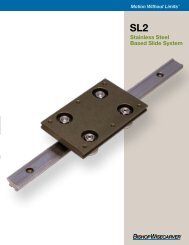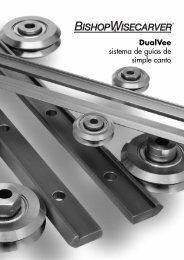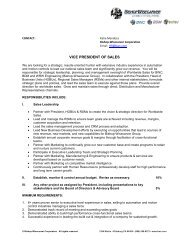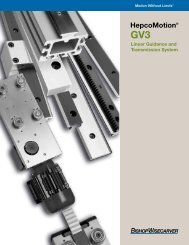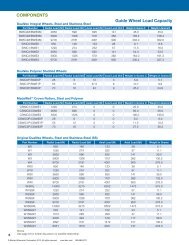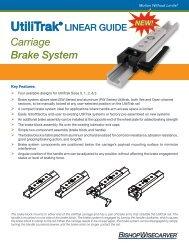Motion Without Limits - Bishop-Wisecarver Corp.
Motion Without Limits - Bishop-Wisecarver Corp.
Motion Without Limits - Bishop-Wisecarver Corp.
You also want an ePaper? Increase the reach of your titles
YUMPU automatically turns print PDFs into web optimized ePapers that Google loves.
COMPONENTS<br />
TECHNICAL REFERENCE<br />
Lubrication will also increase the maximum linear velocity<br />
that a DualVee bearing arrangement can endure. In applications<br />
where high speed or high acceleration rates<br />
are present, lubrication of the wheel/track interface is<br />
highly recommended. Lastly, lubrication will reduce<br />
the overall coefficient of friction of the guide, which,<br />
depending on the level of preload, can fall anywhere<br />
from 0.008 to 0.015. The availability of lubricators and<br />
wheel covers gives design engineers an opportunity<br />
to design lubrication right into the DualVee mechanism<br />
with little effort. See specifications on wheel covers and<br />
lubricators for more details (pgs 16 and 17).<br />
The other main factor affecting wear resistance is lubrication.<br />
Wheel covers or lubricators should be designed in<br />
whenever possible. Both will distribute a thin coating of oil<br />
lubricant along the contact surface of the DualVee track.<br />
The wheel covers offer added protection by preventing<br />
debris from entering the wheel/track contact surface.<br />
Lubricated and relatively clean wheel/track contact<br />
surfaces will ensure maximum service life in a DualVee<br />
linear guide.<br />
As the hardness of the contaminants approaches the<br />
hardness of the track and wheels, the wear rate will<br />
increase. For these cases, an adjustment factor (see<br />
page 23) should be applied to maximum axial and radial<br />
working load capacities to provide a longer operating<br />
life.<br />
Wheel Carriage Configurations<br />
In designing a wheel carriage, it is important to use the<br />
right combination of eccentric and concentric guide<br />
wheels depending on the configuration. The linear<br />
systems should always have two concentric wheels and<br />
all the other guide wheels should be eccentric. The eccentric<br />
wheels are adjusted to remove the play between<br />
the wheels and track, equally loading all the wheels so<br />
they roll instead of sliding or skipping on the track due<br />
to acceleration. When the wheel carriage is loaded in the<br />
radial direction, the concentric wheel should carry the<br />
primary load.<br />
Eccentric<br />
Wheel<br />
Wheel<br />
Carriage<br />
Lubrication<br />
Lubrication is the key to maximizing the life of a DualVee<br />
linear guide. Internally, DualVee guide wheels are lubricated<br />
for life with an extreme pressure, corrosion resistant<br />
grease.<br />
The lubrication of the wheel/track interface is the responsibility<br />
of the user.<br />
Lubrication of the guide ways will maximize the load<br />
capacity of the system and will significantly increase the<br />
service life over a non-lubricated configuration under the<br />
same loads. A light machine oil or an extreme pressure<br />
grease will minimize wear, stick slip, and corrosion on the<br />
guide ways in a DualVee-based design.<br />
Load<br />
Concentric<br />
Wheel<br />
Concentric<br />
Wheel<br />
Eccentric<br />
Wheel<br />
Wheel<br />
Carriage<br />
Load<br />
26<br />
© <strong>Bishop</strong>-<strong>Wisecarver</strong> <strong>Corp</strong>oration 2010. All rights reserved www.bwc.com 888.580.8272



